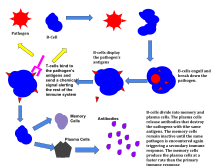Immune response
The Immune response is the body's response caused by its immune system being activated by antigens. The immune response can include immunity to pathogenic microorganisms and its products, as well as autoimmunity to self-antigens, allergies, and graft rejections. In this process the main cells involved are T cells and B cells (subtypes of lymphocytes), and macrophages (a type of leucocyte or white blood cell). These cells produce lymphokines that influence the other host cells' activities. B cells mature to produce immunoglobulins (also known as antibodies), that react with antigens. At the same time, macrophages process the antigens into immunogenic units which stimulate B lymphocytes to differentiate into antibody-secreting plasma cells, stimulating the T cells to release lymphokines.[1]
Complement is a group of normal serum proteins that enhance the immune response by becoming activated as the result of antigen-antibody interaction. The first contact with any antigen sensitize individual affected and promote the primary immune response. Next of the sensitized individuals with same antigen result in a more rapid and massive reaction, called the secondary immune response ("booster response" or the "anamnestic reaction"). It is most expressed in the level of circulating serum antibodies.[2][3]
An anamnestic response in medicine is a delayed immunologic response. The term is frequently used in transfusion medicine and refers to a re-exposure incident where antibody is formed on initial exposure to an antigen in a transfused unit, but the specific memory B cell population fades over time, with antibody becoming undetectable over years. If a patient is re-exposed to the same offending antigen in a future transfusion (which might happen because the antibody screen would in fact be negative), there would still be a massive, rapid production of IgG antibody against the antigen, which will predictably lyse the transfused red cells, a delayed hemolytic transfusion reaction.

The immune response can be transferred via serum antibodies introduction from sensitised to unsensitised individuals. It is highly specific for given antigen, and it is normally directed against foreign protein substances.[2]
References
- ↑ King R. C., Stransfield W. D. (1998). Dictionary of genetics. New York, Oxford: Oxford University Press. ISBN 0-19-50944-1-7.
- 1 2 Hadžiselimović R., Pojskić N. (2005). Uvod u humanu imunogenetiku / Introduction to Human Immunogenetics. Sarajevo: INGEB. ISBN 9958-9344-3-4.
- ↑ Lawrence E., Ed., ed. (1999). Henderson's Dictionary of Biological Terms. London: Longman. ISBN 0-582-22708-9.
External links
| Wikimedia Commons has media related to Immune response. |